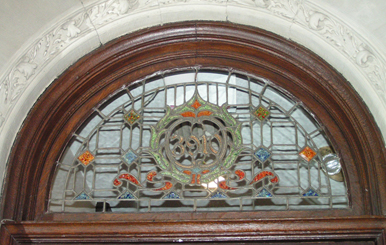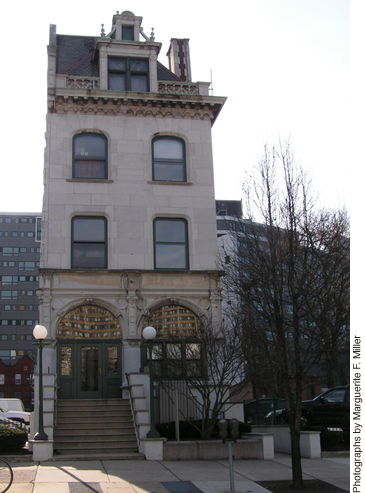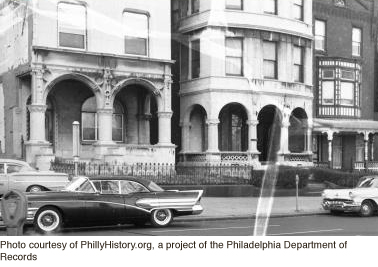| 3910 Chestnut Street: A Building with a Storied Past |
|
January 12, 2010,
Volume 56, No. 17
|

|
| Architect Horace Trumbauer was born in Philadelphia in 1868 and died in 1938; he was buried in West Laurel Hill Cemetery. |
The story of 3910 Chestnut Street began in 1878, when William M. Sinclair purchased the 100 ft. wide lot from the estate of Sarah P. Rose, in the village of Hamilton, which was in the township of Blockley, in the county of Philadelphia. The house was built as a twin, sometime between 1878-1882, with 3908 Chestnut Street designed by James Windrim and Son, who also designed the Academy of Natural Sciences and the Bell Telephone Building at 3810 Chestnut. In 1882, Sinclair sold the 3908 half of the lot with a house to Louisa C. Smith.
The second owner of the 3910 home was James A. Connelly, a cotton manufacturer who was born in Philadelphia, the son of Irish immigrants. A member of the Vestry of the Episcopal Church of the Savior on 38th Street, he bought the house and stable on December 11, 1895 and in 1896, hired renowned architect Horace Trumbauer to redesign the home’s façade and make extensive changes.
Trumbauer, a prominent architect of the Gilded Age, had developed a reputation for designing extravagant private residences for wealthy clients. He also went on to design several notable buildings in Philadelphia, including the Free Library on Logan Square (1925), the Union League (1909) as well as Irvine Auditorium (1926-1932), Otto Eisenlohr Hall (1912)—now the President’s House, and 4200 Pine, built for Marie Eisenlohr (1904). Some of Trumbauer’s later work is often attributed to the assistant he hired in 1906, Julian Abele, the first African-American graduate of the University of Pennsylvania Architecture School.
In the 1920s and 30s, the home was owned by an obstetrician, Dr. Collin Foulkrod, and his wife Gertrude, who received a certificate in music proficiency from Penn in 1898. Dr. Foulkrod was a 1901 graduate of Jefferson Medical College where he later taught. He was widely published, and was also a member of the staff at Presbyterian Hospital and a fellow of the American College of Surgeons. Three months after his death in 1939, his family lost the house at a sheriff sale.
In 1940, the insurance company that bought the house quickly sold it to an Armenian antique dealer, Dikran Boyajian and his wife Rose. Their son, Richard, attended West Philadelphia High School and earned a certificate of proficiency from the Wharton Evening School of Accounts in 1941. He remained in University City until his death in 1997.
The Boyajian family sold the house in 1968 to Joseph Pagano and his wife, Virginia. They devoted a year to detailed restoration and converted the old house into an Italian restaurant aptly named Casa Vecchia, which was decorated with red velvet walls, converted gas lights, and statuary. Pagano’s Casa Vecchia was housed in this building from 1970 until 1987. Back in 1979, the lunch menu included $2 sandwiches, and luncheons for $3.50. The University purchased the home from the Pagano family in 1987 after the 1986 death of Mr. Pagano, one of the city’s best-known restauranteurs.
In 1989, the first floor was home to Speedie’s Sports Pub, run by Adam Spivack. He called the place Speedie’s as an homage to his grandfather who had a chain of bars by the same name in Philadelphia in the 1930s, 40s and 50s.
Meanwhile Penn has utilized the spacious four-story limestone structure to house the PhD Center for Studies on Addiction and Department of Psychiatry in the School of Medicine; the Graduate School of Education’s National Center on Adult Literacy and the International Literacy Institute. In 1984, the building was the site of a hostage situation involving the abduction of a Penn employee (Almanac September 4, 1984).
Today, the building is home to three Penn entities, the Penn Fund Calling Center, the Pennsylvania Gazette and Almanac.
 |
Left: The French Gothic city house acquired by Penn after it had been a residence and a restaurant has been offices for various departments. Below, a view of the block from January 14, 1959, before the front porch was enclosed.

PhillyHistory.org is a mapping website that allows users to search for, view by location, and purchase thousands of historic photographs dating back to the late nineteenth century. |
|